ignition Acura TSX 2004 Owner's Manual
[x] Cancel search | Manufacturer: ACURA, Model Year: 2004, Model line: TSX, Model: Acura TSX 2004Pages: 364, PDF Size: 5.35 MB
Page 28 of 364

Many parents say they pref er to put
an inf ant or small child in the f ront
passenger seat so they can watch the
child, or because the child requires
attention.
Placing a child in the f ront seat
exposes the child to hazards f rom
the passenger’s f ront airbag, and
paying close attention to a child
distracts the driver f rom the
important tasks of driving, placing
both of you at risk.
If a child requires physical attention
or f requent visual contact, we
strongly recommend that another
adult ride with the child in the back
seat. The back seat is far safer for a
child than the front.Using this f eature will
prevent children f rom opening the
doors and accidentally f alling out
(see page ). Leaving children without
adult supervision is illegal in most
states and Canadian provinces,
and can be very hazardous. For
example, inf ants and small
childrenleftinacaronahotday
can die f rom heatstroke. And
children lef t alone with the key in
the ignition can accidentally set
the car in motion, possibly injuring
themselves or others.
Using
this f eature will prevent children
f rom playing with the windows,
which could expose them to
hazards or distract the driver (see
page ). 87
97
CONT INUED
Protecting Children
Driver and Passenger Saf ety
If a Child Requires Close
Attention Additional Saf ety Precautions
Use childproof door locks t o
prevent children f rom opening t hedoors. Do not leave children alone in your
car.
Use t he main power window swit ch t o prevent children f romopening t he rear windows.
25
Page 29 of 364
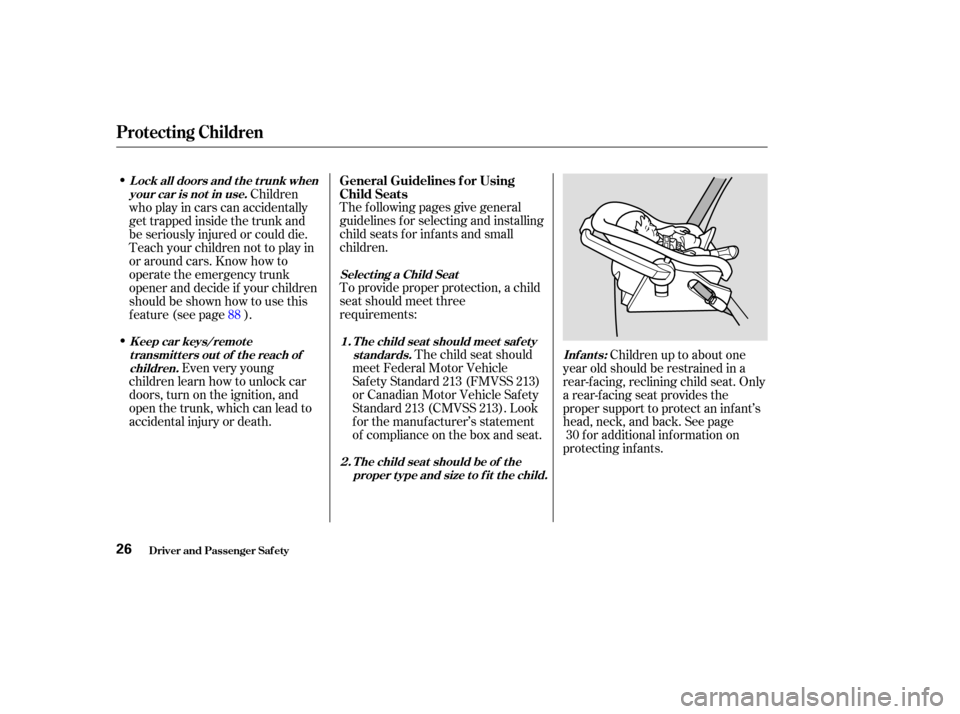
The f ollowing pages give general
guidelines f or selecting and installing
child seats f or inf ants and small
children.
To provide proper protection, a child
seat should meet three
requirements:The child seat should
meet Federal Motor Vehicle
Saf ety Standard 213 (FMVSS 213)
or Canadian Motor Vehicle Saf ety
Standard 213 (CMVSS 213). Look
for the manufacturer’s statement
of compliance on the box and seat.
Children
who play in cars can accidentally
get trapped inside the trunk and
be seriously injured or could die.
Teach your children not to play in
or around cars. Know how to
operate the emergency trunk
opener and decide if your children
should be shown how to use this
feature(seepage ).
Even very young
children learn how to unlock car
doors, turn on the ignition, and
openthetrunk,whichcanleadto
accidental injury or death. Childrenuptoaboutone
year old should be restrained in a
rear-f acing, reclining child seat. Only
a rear-f acing seat provides the
proper support to protect an inf ant’s
head, neck, and back. See page for additional information on
protecting inf ants. 30
88 General Guidelines f or Using
Child Seats
Select ing a Child Seat
T he child seat should meet saf et yst andards.
L ock all doors and t he t runk when
your car is not in use.
K eep car keys/remot etransmitters out of the reach ofchildren.
T he child seat should be of theproper t ype and size t o f it t he child. Inf ant s:
2.
1.
Protecting Children
Driver and Passenger Saf ety26
Page 46 of 364
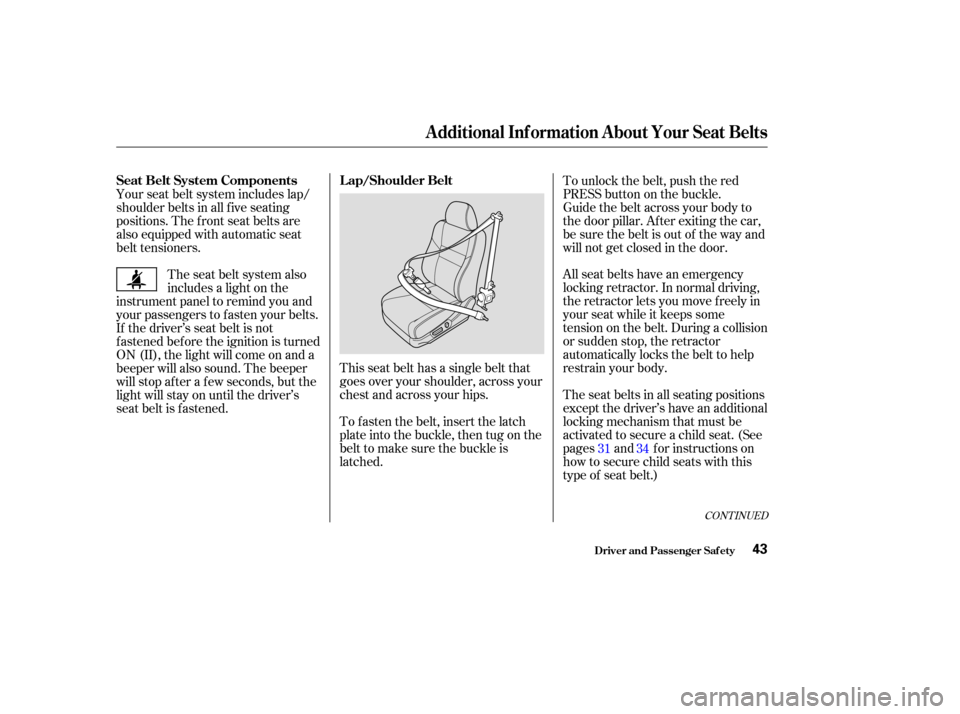
This seat belt has a single belt that
goes over your shoulder, across your
chest and across your hips.The seat belts in all seating positions
except the driver’s have an additional
locking mechanism that must be
activated to secure a child seat. (See
pages and f or instructions on
how to secure child seats with this
type of seat belt.) All seat belts have an emergency
locking retractor. In normal driving,
the retractor lets you move f reely in
your seat while it keeps some
tension on the belt. During a collision
or sudden stop, the retractor
automatically locks the belt to help
restrain your body. Guide the belt across your body to
the door pillar. Af ter exiting the car,
be sure the belt is out of the way and
will not get closed in the door. To unlock the belt, push the red
PRESSbuttononthebuckle.
To fasten the belt, insert the latch
plate into the buckle, then tug on the
belt to make sure the buckle is
latched.
Your seat belt system includes lap/
shoulder belts in all f ive seating
positions. The f ront seat belts are
also equipped with automatic seat
belt tensioners.
The seat belt system also
includes a light on the
instrument panel to remind you and
your passengers to f asten your belts.
If the driver’s seat belt is not
fastened before the ignition is turned
ON (II), the light will come on and a
beeper will also sound. The beeper
will stop af ter a f ew seconds, but the
light will stay on until the driver’s
seat belt is f astened.
31 34
CONT INUED
Seat Belt System Components L ap/Shoulder Belt
Additional Inf ormation About Your Seat Belts
Driver and Passenger Saf ety43
Page 49 of 364
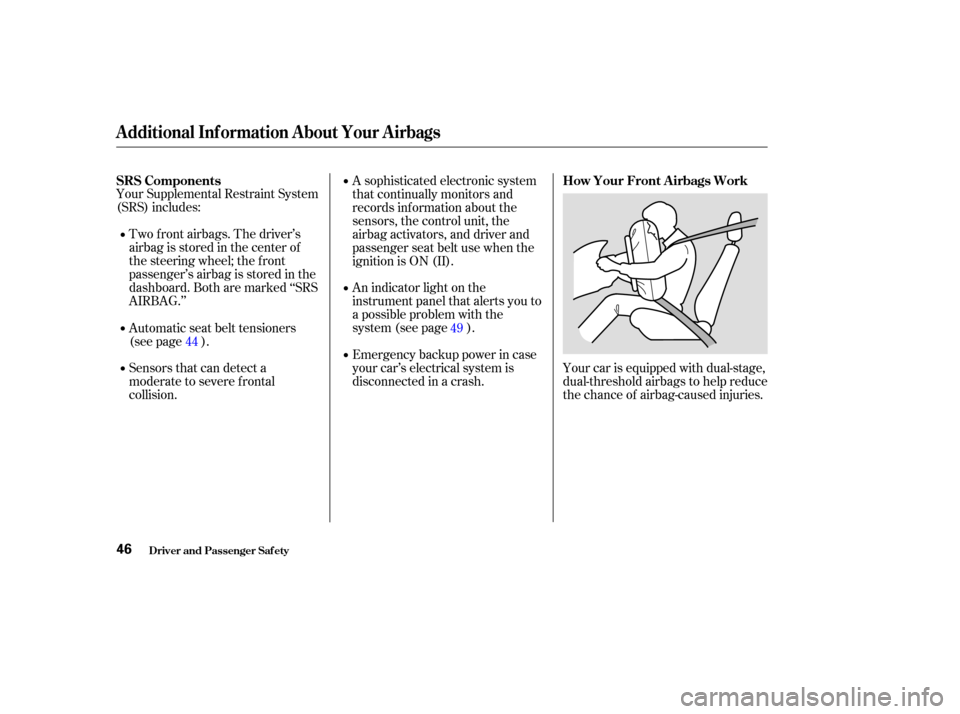
Your Supplemental Restraint System
(SRS) includes:Two f ront airbags. The driver’s
airbag is stored in the center of
the steering wheel; the f ront
passenger’sairbagisstoredinthe
dashboard. Both are marked ‘‘SRS
AIRBAG.’’
Emergency backup power in case
your car’s electrical system is
disconnected in a crash. An indicator light on the
instrument panel that alerts you to
a possible problem with the
system (see page ). A sophisticated electronic system
that continually monitors and
records inf ormation about the
sensors, the control unit, the
airbag activators, and driver and
passenger seat belt use when the
ignition is ON (II).
Your car is equipped with dual-stage,
dual-threshold airbags to help reduce
the chance of airbag-caused injuries.
Automatic seat belt tensioners
(see page ).
Sensors that can detect a
moderate to severe frontal
collision.
44
49
SRS Components
How Your Front A irbags Work
Additional Inf ormation About Your Airbags
Driver and Passenger Saf ety46
Page 52 of 364
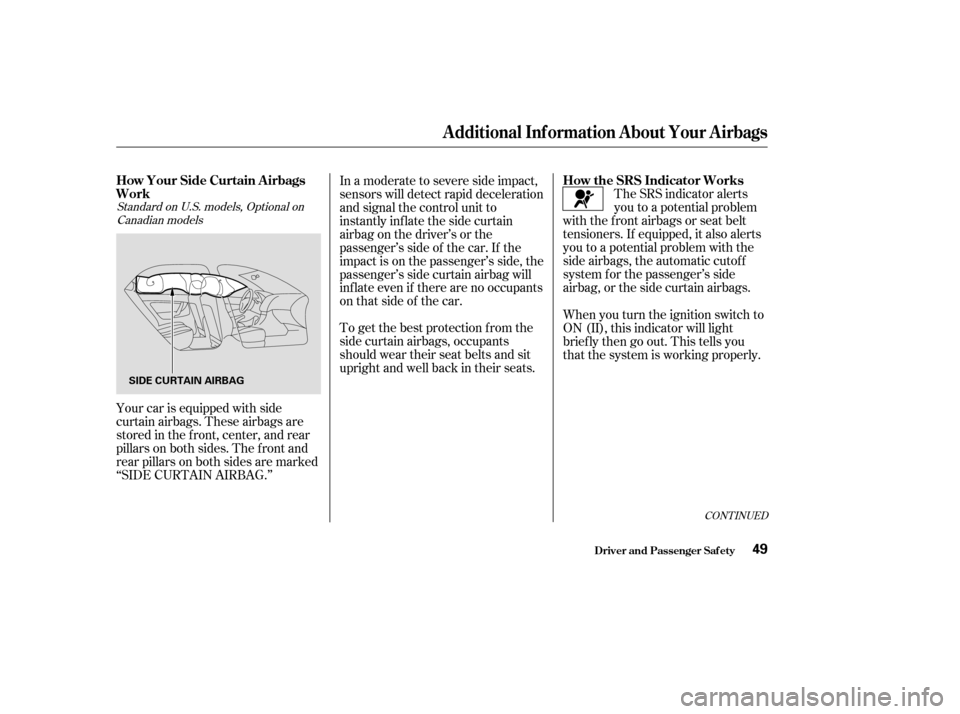
The SRS indicator alerts
you to a potential problem
with the f ront airbags or seat belt
tensioners. If equipped, it also alerts
you to a potential problem with the
side airbags, the automatic cutoff
system f or the passenger’s side
airbag, or the side curtain airbags.
In a moderate to severe side impact,
sensors will detect rapid deceleration
and signal the control unit to
instantly inflate the side curtain
airbag on the driver’s or the
passenger’s side of the car. If the
impact is on the passenger’s side, the
passenger’s side curtain airbag will
inflate even if there are no occupants
on that side of the car.
To get the best protection f rom the
side curtain airbags, occupants
should wear their seat belts and sit
upright and well back in their seats.
Your car is equipped with side
curtain airbags. These airbags are
stored in the f ront, center, and rear
pillars on both sides. The f ront and
rear pillars on both sides are marked
‘‘SIDE CURTAIN AIRBAG.’’ When you turn the ignition switch to
ON (II), this indicator will light
brief ly then go out. This tells you
that the system is working properly.
CONT INUED
Standard on U.S. models, Optional on
Canadian models
How the SRS Indicator Works
How Your Side Curtain A irbags
Work
Additional Inf ormation About Your Airbags
Driver and Passenger Saf ety49
SIDE CURTAIN AIRBAG
Page 53 of 364

If the light comes on at any other
time, or does not come on at all, you
should have the system checked by
your dealer. For example:If the SRS indicator light does not
come on after you turn the ignition
switch to ON (II).
If the light stays on after the
engine starts.
If the light comes on or f lashes on
andoff whileyoudrive. This light alerts you that
the passenger’s side airbag
has been automatically shut off.
To reduce the risk of injury f rom an
inf lating side airbag, your car has an
automatic cutoff system for the
passenger’s side airbag.
It does not mean there is a problem
with your side airbags. It means that
thesideairbagcutoff systemhas
activated to prevent the side airbag
f rom deploying.
If you see any of these indications,
your airbags may not deploy, your
passenger’s side airbag automatic
cutof f system may not work properly,
or your seat belt tensioners may not
work when you need them. See your
Acura dealer as soon as possible.
How the Side Airbag Cutof f
Indicator L ight Works
Additional Inf ormation About Your Airbags
Driver and Passenger Saf ety50
Ignoring the SRS indicator light
can result in serious injury or
death if the airbags, cutoff
system, or tensioners do not
work properly.
Have your car checked by a
dealer as soon as possible if
the SRS light alerts you to a
potential problem.
Page 54 of 364

A f ront seat passenger should not
use a cushion or other object as a
backrest. It may prevent the cutof f
system f rom working properly.
When you turn the ignition switch to
ON (II), the indicator should light
brief ly and go out (see page ). If it
doesn’t light, stays on, or comes on
while driving without a passenger in
the front seat, have the system
checked.
If a small-statured adult leans
sideways, or larger adult slouches
and leans sideways into the
deployment path of the side airbag,
the system may also shut of f the side
airbag.
If the side airbag cutof f indicator
light comes on, you should have the
passenger sit upright. Once the
passenger is out of the deployment
path of the side airbag, the system
will turn the airbag back on and the
light will go out. Although Acura does not encourage
children to ride in the f ront seat, this
system is designed to shut of f the
side airbag if a child leans sideways
and the child’s head is in the side
airbag deployment path. Your airbag systems are virtually
maintenance-f ree, and there are no
parts you can saf ely service.
However, you must have your car
serviced if :
Any
airbag that has deployed must be
replaced along with the control
unit, automatic seat belt
tensioners and other related parts.
Do not try to remove or replace
anyairbagbyyourself.Thismust
be done by an Acura dealer or a
knowledgeable body shop.
Take your car to an
authorized Acura dealer as soon as
possible. If you ignore this
indication, the airbags might not
inf late when you need them.
61
Additional Inf ormation About Your Airbags
Driver and Passenger Saf ety
Airbag Service
Your airbags ever inf late.
T he SRS indicat or light alert s yout o a problem.
51
Page 60 of 364

This section gives inf ormation about
the controls and displays that
contribute to the daily operation of
your Acura. All the essential controls
are within easy reach............................
Control Locations .58
...............................
Indicator Lights .59
.............................................
Gauges .65
...............................
Speedometer .65
.................................
Tachometer .65
.....................................
Odometer .65
Outside Temperature ...................................
Indicator .66
...................................
Trip Meter .66 ...................
Temperature Gauge . 66
..................................
Fuel Gauge .67
Maintenance Required ...................................
Indicator .67
Controls Near the Steering .......................................
Wheel .69
...................................
Headlights .70
Automatic Lighting Off .....................................
Feature .71
............
Daytime Running Lights . 72
....
Instrument Panel Brightness . 72
................................
Turn Signals .73
.....................
Windshield Wipers .73
..................
Windshield Washers . 75
..........................
Hazard Warning .75
.............
Rear Window Def ogger . 75
......
Steering Wheel Adjustment . 76
...............................
Keys and Locks .77
..............................................
Keys .77
....................
Immobilizer System . 79
............................
Ignition Switch .80
......................
Power Door Locks .81
...................
Remote Transmitter . 83
..............
Childproof Door Locks . 87
...........................................
Trunk .87
........
Emergency Trunk Opener . 88....................................
Glove Box .89
............................
Seat Adjustments .90
Driver’s Seat Full Power ............................
Adjustments .90
...........
Driver’s Lumbar Support . 91
Front Passenger’s Seat ............................
Adjustments .92
..........................
Head Restraints .93
.......................
Folding Rear Seat .94
......................
Rear Seat Armrest .95
....................................
Seat Heaters .96
..............................
Power Windows .97
.......................................
Moonroof .101
...........................................
Mirrors .102
..
Adjusting the Power Mirrors . 102
...............................
Parking Brake .104
.................
Console Compartment . 105
..........................................
Armrest .105
.........................
Beverage Holders .106
.........................
Center CD Pocket .107
.................................
Utility Pocket .107
........................................
Sun Visor .108
................................
Vanity Mirror .108
........................
Sunglasses Holder .109
............
Accessory Power Sockets . 109
...............................
Interior Lights .110
Instruments and Controls
Inst rument s and Cont rols57
Page 63 of 364
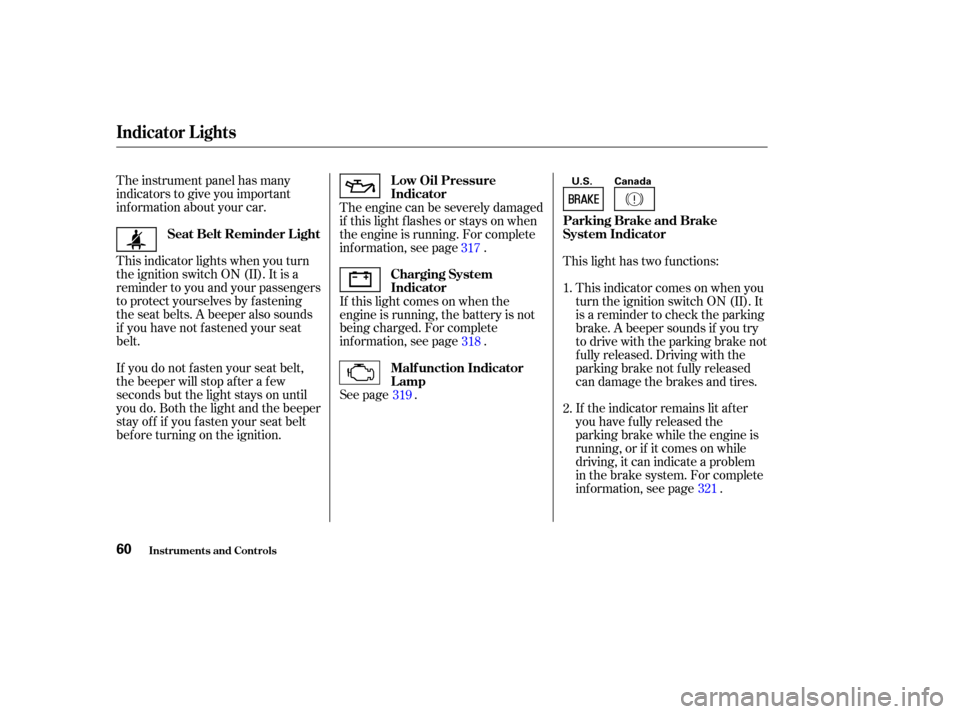
The instrument panel has many
indicators to give you important
inf ormation about your car.
This indicator lights when you turn
the ignition switch ON (II). It is a
reminder to you and your passengers
to protect yourselves by f astening
the seat belts. A beeper also sounds
if you have not fastened your seat
belt.
If you do not f asten your seat belt,
the beeper will stop af ter a f ew
seconds but the light stays on until
you do. Both the light and the beeper
stay of f if you f asten your seat belt
bef ore turning on the ignition.The engine can be severely damaged
if this light f lashes or stays on when
the engine is running. For complete
inf ormation, see page .
If this light comes on when the
engine is running, the battery is not
being charged. For complete
inf ormation, see page .
See page .
This light has two f unctions:
This indicator comes on when you
turn the ignition switch ON (II). It
is a reminder to check the parking
brake. A beeper sounds if you try
to drive with the parking brake not
f ully released. Driving with the
parking brake not f ully released
can damage the brakes and tires.
If the indicator remains lit after
you have f ully released the
parking brake while the engine is
running, or if it comes on while
driving, it can indicate a problem
in the brake system. For complete
inf ormation, see page .
1.
2.
317
318
319
321
Indicator L ights
Inst rument s and Cont rols
Seat Belt Reminder L ightL ow Oil Pressure
Indicator
Charging System
Indicator
Malf unction Indicator
LampParking Brake and Brake
System Indicator
60
U.S. Canada
Page 64 of 364
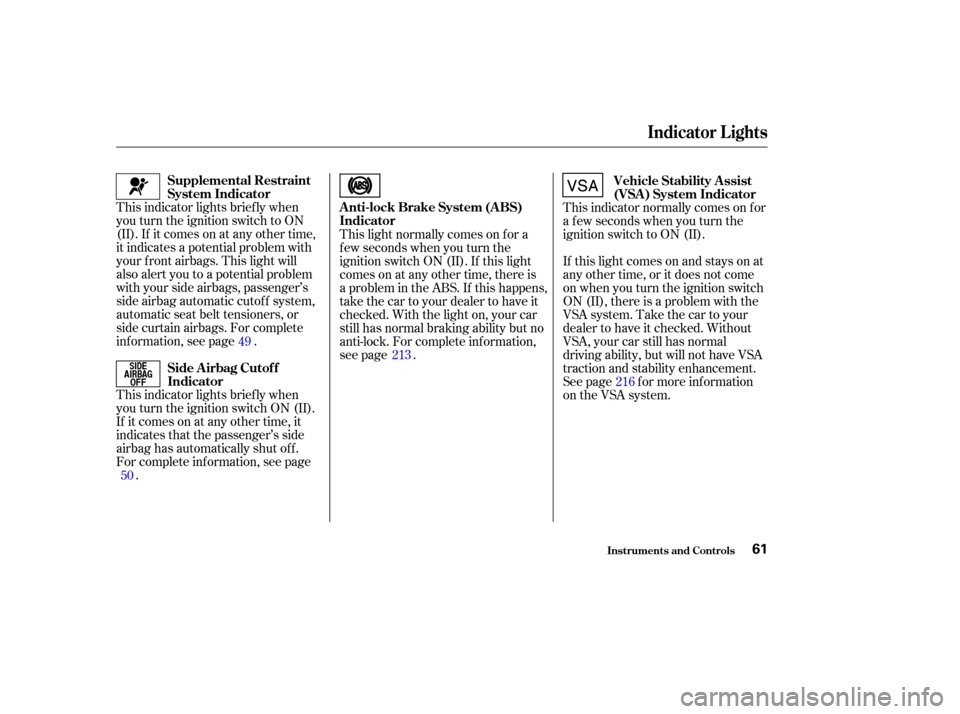
This indicator lights brief ly when
you turn the ignition switch to ON
(II). If it comes on at any other time,
it indicates a potential problem with
your f ront airbags. This light will
also alert you to a potential problem
with your side airbags, passenger’s
side airbag automatic cutoff system,
automatic seat belt tensioners, or
side curtain airbags. For complete
inf ormation, see page .
This indicator lights brief ly when
you turn the ignition switch ON (II).
If it comes on at any other time, it
indicates that the passenger’s side
airbag has automatically shut off.
For complete inf ormation, see page. This light normally comes on f or a
f ew seconds when you turn the
ignition switch ON (II). If this light
comes on at any other time, there is
a problem in the ABS. If this happens,
take the car to your dealer to have it
checked. With the light on, your car
still has normal braking ability but no
anti-lock. For complete inf ormation,
see page .
This indicator normally comes on f or
a f ew seconds when you turn the
ignition switch to ON (II).
If this light comes on and stays on at
any other time, or it does not come
on when you turn the ignition switch
ON (II), there is a problem with the
VSA system. Take the car to your
dealer to have it checked. Without
VSA, your car still has normal
driving ability, but will not have VSA
traction and stability enhancement.
See page f or more inf ormation
on the VSA system.
49
50 213
216
Indicator L ights
Inst rument s and Cont rols
Supplemental Restraint
System IndicatorAnti-lock Brake System (ABS)
Indicator
Side A irbag Cutof f
Indicator Vehicle Stability Assist
(VSA ) System Indicator
61